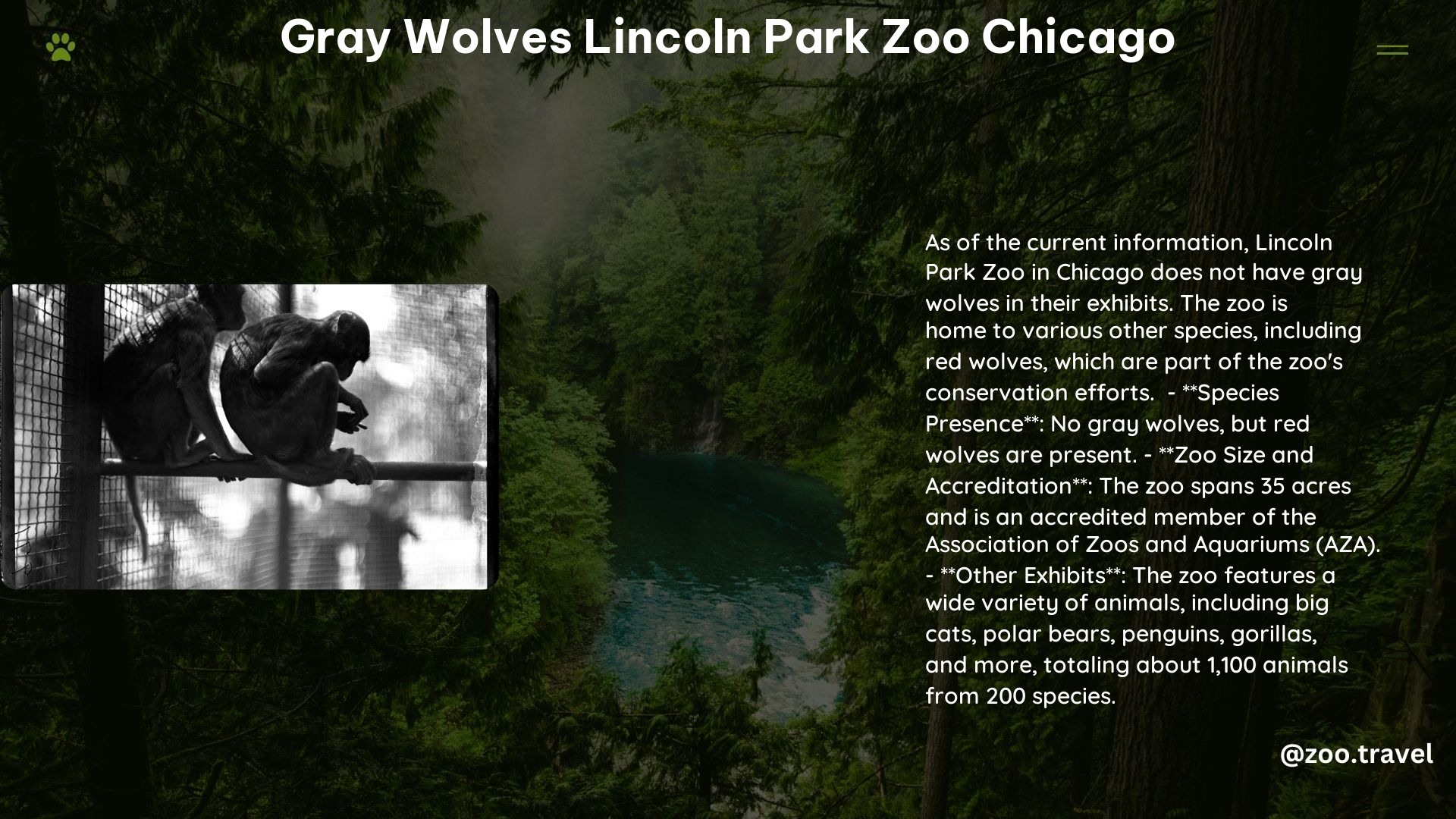Gray wolves, once a prominent species in North America, have a complex history with human populations. While Lincoln Park Zoo in Chicago is renowned for its diverse animal exhibits, it’s important to note that the zoo does not currently house gray wolves. Instead, the zoo focuses on the conservation and exhibition of red wolves, a critically endangered species native to the southeastern United States. This article will explore the wolf presence at Lincoln Park Zoo, highlighting the red wolf program and drawing comparisons to gray wolves where relevant.
What is the History of Wolves at Lincoln Park Zoo?

Lincoln Park Zoo has a long-standing commitment to wildlife conservation and education. While gray wolves are not part of the current animal collection, the zoo has dedicated significant resources to the preservation of the red wolf species. This focus aligns with the zoo’s mission to connect people with nature and protect wildlife.
Red Wolf Conservation Timeline:
- 1980s: Red wolves declared extinct in the wild
- 1987: Reintroduction efforts begin
- Early 2000s: Lincoln Park Zoo joins the Red Wolf Species Survival Plan®
- Present: Ongoing breeding and conservation efforts at the zoo
How Does the Wolf Habitat at Lincoln Park Zoo Compare to Gray Wolf Habitats?

The red wolf habitat at Lincoln Park Zoo’s Pritzker Family Children’s Zoo is designed to mimic the natural environment of these canines. While gray wolves and red wolves have different native ranges, their habitat needs share some similarities.
| Feature | Red Wolf Habitat at LPZ | Typical Gray Wolf Habitat |
|---|---|---|
| Size | Extra long for running | Large territories in the wild |
| Vegetation | Mixed forest and grassland | Varies from tundra to forests |
| Water Source | Included | Essential in natural habitats |
| Den Areas | Provided for privacy | Critical for breeding in the wild |
The zoo’s habitat designers have taken great care to create an environment that allows the wolves to express natural behaviors, which would be similar for both red and gray wolves in many aspects.
What Are the Key Differences Between Red Wolves and Gray Wolves?
While both species are part of the Canis genus, there are notable differences between red wolves and gray wolves:
- Size:
- Red wolves are smaller, weighing 45-80 pounds
-
Gray wolves are larger, weighing 70-145 pounds
-
Coloration:
- Red wolves have a reddish-brown coat with black tips
-
Gray wolves have a range of colors from gray to brown to black
-
Native Range:
- Red wolves historically inhabited the southeastern United States
-
Gray wolves had a much broader range across North America
-
Conservation Status:
- Red wolves are critically endangered with only about 30 left in the wild
- Gray wolves, while once endangered, have seen population recoveries in some areas
Why Does Lincoln Park Zoo Focus on Red Wolves Instead of Gray Wolves?
Lincoln Park Zoo’s commitment to red wolf conservation stems from the critical status of this species. The decision to focus on red wolves aligns with several key factors:
-
Urgent Conservation Need: With only about 30 red wolves left in the wild, every conservation effort is crucial for the species’ survival.
-
Specialized Expertise: The zoo has developed specific knowledge and facilities for red wolf care and breeding.
-
Participation in SSP: As part of the Red Wolf Species Survival Plan®, Lincoln Park Zoo plays a vital role in coordinated breeding efforts across accredited institutions.
-
Regional Relevance: While not native to Illinois, red wolves are part of North American wildlife heritage, making them relevant to the zoo’s educational mission.
-
Space Considerations: Zoos must make strategic decisions about which species to house based on available space and resources.
How Does Lincoln Park Zoo Contribute to Wolf Conservation?
Despite not housing gray wolves, Lincoln Park Zoo’s wolf conservation efforts are significant:
- Breeding Program: Participation in the Red Wolf SSP to maintain genetic diversity
- Cross-Fostering: Placing zoo-born pups with wild packs to boost wild populations
- Research: Conducting studies on wolf behavior and health to improve conservation strategies
- Public Education: Raising awareness about wolf conservation through exhibits and programs
What Can Visitors Learn About Wolves at Lincoln Park Zoo?
While gray wolves are not present, visitors to Lincoln Park Zoo can gain valuable insights into wolf ecology and conservation:
- Red Wolf Behavior: Observe natural behaviors in a carefully designed habitat
- Conservation Challenges: Learn about the threats facing wolf populations in the wild
- Ecosystem Roles: Understand the importance of predators in maintaining ecological balance
- Human-Wildlife Conflict: Explore the complex relationship between wolves and human communities
- Conservation Success Stories: Discover how zoos contribute to species recovery efforts
How Can the Public Support Wolf Conservation at Lincoln Park Zoo?
Lincoln Park Zoo offers several ways for the public to get involved in wolf conservation:
- Adopt a Red Wolf: Symbolic adoption programs support animal care and conservation
- Donate to Conservation Funds: Direct financial support for wolf research and protection
- Volunteer Opportunities: Assist with education and outreach programs
- Attend Educational Events: Participate in zoo-hosted lectures and workshops on wolf conservation
- Spread Awareness: Share knowledge about wolf conservation with friends and family
What Future Plans Does Lincoln Park Zoo Have for Wolf Conservation?
While specific plans may evolve, Lincoln Park Zoo remains committed to wolf conservation. Potential future initiatives could include:
- Expanded breeding programs
- Enhanced visitor education experiences
- Increased participation in wild release programs
- Collaborative research with other institutions on wolf ecology and behavior
Conclusion
Although gray wolves are not currently part of the Lincoln Park Zoo collection, the zoo’s dedication to wolf conservation is evident through its red wolf program. By focusing on this critically endangered species, the zoo contributes significantly to wolf conservation efforts. Visitors to Lincoln Park Zoo have the unique opportunity to learn about and support wolf conservation, even in the absence of gray wolves. The zoo’s work with red wolves serves as a powerful example of the role that zoological institutions can play in protecting and preserving endangered species for future generations.
References:
1. Lincoln Park Zoo – Red Wolf
2. U.S. Fish & Wildlife Service – Red Wolf Recovery Program
3. Wolf Conservation Center – Red Wolf vs. Gray Wolf
